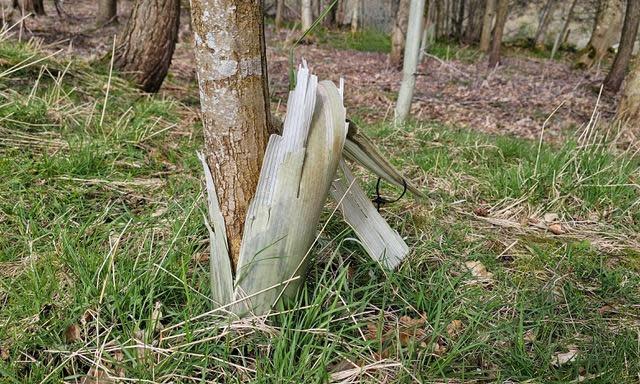Country diary: A glorious springtime copse, blighted by discarded tree guards

A hare springs away over the swell of the hill as we drop down into the wood. On this bright morning, a mistle thrush flings its clear song on to the breeze. Wild garlic shines emerald beneath the trees and woodrush thrusts through fallen beech leaves. Other signs of spring: arrow-shaped lords-and-ladies, pale green flowers of dog’s mercury and, on a sheltered bank, the first primroses.
There’s a feeling of movement, of growth, of upward vitality. The thing that jars is that which is not alive: the twisted, distorted tubes of long-ago tree guards, redundant now that the trees have grown. They cling on, cloven in two, forced apart by bark, still attached to mossy stakes by black ties. Or tumbled and half buried in grass and soil, where they will remain for many years. In an act of guerrilla tidying, we gather a load of the split, broken, battered plastic and pile it under an old piece of wriggly tin. These pieces will still break down into microplastics, but removing them frees the struggling trunks.
Related: Country diary: For the dying ash, one last push for greatness | Derek Niemann
This is just a small copse in Northumberland, but this scene is replicated across the country. In this last week I’ve seen: sand-coloured straps of plastic like giant tagliatelle wrapped round a hazel on a nature reserve; a roadside red-stemmed dogwood half-throttled as it tries to throw off its burden; and a top-heavy hawthorn hedge, its marching line of white tubes masking a barren base (to be stock-proof, a hedge needs to be dense right from the base).
Tree guards are used to protect new plantings from rabbits, hares, voles and an ever-expanding deer population. They are, in theory, reusable or recyclable, but few are collected once they are no longer needed, and probably damaging the tree and littering the countryside. Biodegradable alternatives being trialled by the Woodland Trust, the National Trust and the Tree Council are made from materials such as wool or cardboard.
I’m heartened by two Northumberland farmers. One does indeed collect the tubes and offers them for reuse, and these are snapped up on Facebook. The other is planting a mix of species within wooden post-and-rail cages without individual guards.
• Country diary is on Twitter at @gdncountrydiary
• Susie White’s book Second Nature: The Story of A Naturalist’s Garden is published by Saraband on Thursday 11 April.


